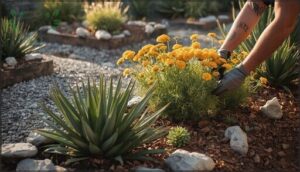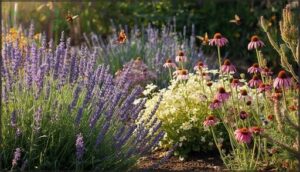This site is supported by our readers. We may earn a commission, at no cost to you, if you purchase through links.

By late July, most lawns look like they’ve surrendered to the sun. But not every plant throws in the towel when water gets scarce. Some thrive right through the hottest stretch, shrugging off dry spells and saving you hours with the hose.
Summer drought-tolerant plants don’t just survive—they transform parched gardens into bold, buzzing landscapes full of color and life. If you’re ready for a garden that keeps its cool while your neighbors’ wilt, get to know the perennials, shrubs, and succulents that make waterwise gardening a breeze. Your summer landscape can be both stunning and sensible.
Table Of Contents
- Key Takeaways
- Benefits of Summer Drought Tolerant Plants
- Preparing Your Garden for Drought Conditions
- Best Summer Drought Tolerant Perennials
- Top Drought-Resistant Shrubs, Grasses, and Succulents
- Design and Care Tips for Drought Tolerant Gardens
- Frequently Asked Questions (FAQs)
- What plants are heat and drought-tolerant?
- What plants can survive in extreme heat?
- What plants don’t require a lot of water?
- What is the hardiest summer flower?
- What plants are good for heat and drought?
- What is the most drought-tolerant plant?
- Which plant will most likely survive a long drought?
- What plants can take full sun and heat?
- What plants need the least amount of water?
- Are summer plants drought tolerant?
- Conclusion
Key Takeaways
- Switching to drought-tolerant plants can cut your outdoor water use by up to 75%, saving money and time on maintenance.
- Perennials like lavender, yarrow, and coneflower thrive in summer heat, attract pollinators, and require very little care once established.
- Smart irrigation, mulching, and choosing the right plant locations help your garden survive dry spells and reduce overall water needs.
- Shrubs, grasses, and succulents like butterfly bush, buffalo grass, and aloe add structure and beauty while handling drought with ease.
Benefits of Summer Drought Tolerant Plants
Switching to drought-tolerant plants isn’t just about surviving summer heat—it’s about making your garden work smarter, not harder.
These resilient plants bring real advantages that go beyond just needing less water. Let’s look at the key benefits that make drought-tolerant gardening such a practical choice.
Water Conservation and Cost Savings
Water conservation isn’t just good for the planet—it lightens your water bill too. Drought tolerant plants can slash outdoor water use by 50% to 75%, saving you real money each month. Some homeowners report bill reductions up to 80% after switching to low-water gardening.
Switching to drought-tolerant plants can cut outdoor water use by up to 75%, dramatically shrinking your monthly water bill
Plus, many utilities offer rebate programs that help offset your xeriscape costs upfront, making long-term savings even sweeter.
In addition, these gardens often require reduced landscape maintenance, freeing up your time.
Low Maintenance and Easy Care
Beyond saving water, drought-tolerant plants deliver the greatest gift: time. Low-maintenance plants like Russian sage and catmint need only one annual cutback—no endless deadheading or fussing. Most reach full establishment in one or two seasons, then thrive on minimal care. Pest resistance is built in, so you skip sprays and constant monitoring.
Many survive in poor soil without fertilizer, making them true plant-and-forget champions for your summer garden. For example, consider adding creeping juniper varieties to create a blue-green carpet.
Supporting Pollinators and Wildlife
Planting drought-tolerant natives creates habitat support that extends beyond your fence line. These plants excel at attracting pollinators like bees and butterflies, even when drought reduces nectar availability and pollen production by up to 70%.
Your garden practices matter: mix continuous bloomers to sustain hummingbird gardens and butterfly gardens through dry spells, helping maintain native biodiversity while supporting wildlife in ways traditional lawns simply can’t match.
Enhancing Garden Beauty and Variety
You don’t have to sacrifice beauty to save water. Drought-tolerant gardens deliver architectural form through sculptural agaves, plant layering with low groundcovers rising to tall grasses, and colorful summer blooms spanning 10–11 months in warm climates.
Mix textures and heights to create garden character, blending Mediterranean herbs with bold floral abundance. Your aesthetic appeal actually improves while water use drops by half.
Preparing Your Garden for Drought Conditions
Getting your garden ready for dry conditions doesn’t have to be complicated. A few smart choices up front can make all the difference between plants that struggle and ones that sail through summer heat.
Let’s look at two key steps that’ll set you up for success.
Choosing The Right Plant Locations
Think of your garden as a series of mini-climates where sun exposure, slope aspects, and soil drainage shape what will thrive. South-facing slopes can receive up to 40% more sunlight, making them perfect for full sun lovers, while partial shade spots stay cooler. Here’s how to match plant to place:
- Check sunlight exposure – most drought-tolerant plants need at least 6 hours of direct sun daily
- Assess your soil drainage – well-draining soil prevents root problems and helps plants access water efficiently
- Map microclimates – note hot spots near pavement and cooler areas under trees to assign the right water regime for each zone
Smart Watering and Mulching Techniques
Smart irrigation systems can slash your watering by 20–50%, saving around 15,000 gallons yearly without sacrificing plant health. Pair them with drip lines for 90% efficiency. Then, spread 2–4 inches of mulch to lock in moisture and cut supplemental watering by up to two-thirds.
| Method | Water Savings | Key Benefit |
|---|---|---|
| Smart Irrigation | 20–50% reduction | Adjusts to real-time weather |
| Drip Systems | 30–80% vs. sprinklers | Targets roots directly |
| Mulching | Up to 66% less watering | Blocks evaporation, builds soil health |
This trio transforms waterwise gardening from aspiration into reality, giving you control over every drop while your drought-tolerant plants flourish.
Best Summer Drought Tolerant Perennials
Perennials are the backbone of any low-water garden because they come back year after year without replanting. Once they’re established, these plants handle summer heat with minimal fuss and keep your garden looking alive when everything else is struggling.
Let’s look at some proven performers that won’t leave you stuck with a hose all season.
Lavender, Yarrow, and Coneflower
Fragrant lavender thrives in hot, sunny spots and offers blooms you can cut for arrangements or dry for sachets. Colorful yarrow, tough as nails, repels mosquitoes and comes in shades from white to deep red. Coneflower benefits your garden by attracting pollinators like bees and butterflies—field studies confirm measurable visits.
These companion plants pair beautifully, create layers of interest, and even have medicinal uses in herbal traditions.
Blanket Flower and Black-Eyed Susan
Blanket flower and black-eyed Susan are champion summer garden plants that bloom nonstop through heat and drought. Both love full sun and accept nearly any soil—even poor, dry ground. Their bloom times stretch from early summer into fall, keeping your beds bright when other flowers fade.
Deadheading tips: Snip spent blooms to encourage more flowers. These companion plants attract pollinators and make low-maintenance gardening a breeze.
Russian Sage and California Poppy
Russian sage stands tall with violet-purple blooms and fragrant foliage that pests avoid—making pest resistance a breeze. Sage propagation is simple through cuttings.
California poppy offers golden, orange, and red poppy varieties that self-seed freely. Both thrive as companion plants in poor, dry soil.
Your summer plant selection just got easier with these low-maintenance plants that embody true drought-tolerant plants for sunny gardens.
Top Drought-Resistant Shrubs, Grasses, and Succulents
If perennials bring the color, then shrubs, grasses, and succulents create the structure and staying power in your drought-tolerant garden. These plants anchor your design with year-round interest while asking very little from you in return.
Let’s look at some standout choices that handle summer heat like champions.
Butterfly Bush and Rosemary
Butterfly bush and rosemary stand out as workhorses in drought-tolerant gardens. Butterfly bush survived extended summer drought in field studies while attracting butterflies all season, even tolerating temperatures down to −28.8 °C.
Rosemary achieved 100% survival under both potable and treated water in trials, making it perfect for hot, dry summer gardens where you want fragrant foliage and companion planting options.
Ornamental Grasses and Sedum
Ornamental grasses bring texture and movement to waterwise gardening without demanding constant attention. Buffalo grass, for example, uses 32–35% less water than tall fescue, making it a smart choice for low-maintenance plants.
Sedum varieties offer even tougher drought resistance:
- Survive 88 days without irrigation on green roofs
- Recover within 1 week after rehydration
- Take 86–254 days to decline under severe drought
- Regain 38% pot cover after 60-day recovery
- Thrive in thin substrates with minimal soil needs
These drought-tolerant plants excel in garden design where water conservation matters most.
Aloe, Cacti, and Mediterranean Herbs
If you’re looking for plants that shrug off summer drought, aloe varieties and cacti are standouts—think prickly pear thriving on just a sip. Their roots boost soil health, while Mediterranean herbs like rosemary and thyme keep growing with little fuss.
Try herb propagation or mix succulents into your xeriscape; these drought-tolerant plants turn tough spots into living art.
Design and Care Tips for Drought Tolerant Gardens
Designing a drought-tolerant garden means thinking beyond just plant choice. How you arrange and care for your space makes all the difference.
Let’s look at a few practical ways to help your garden thrive, even when water is scarce.
Mixing Textures and Colors for Visual Appeal
Blending foliage textures and color palettes is the secret sauce of garden design with drought-tolerant plants. Try mixing fine grasses, bold succulents, and vibrant perennials for layered heights and strong visual rhythm.
Group colorful blooms like black-eyed Susan and lavender for seasonal color, then integrate shrubs and groundcovers to boost plant selection and aesthetic qualities—all while saving water.
Pruning and Seasonal Maintenance
Once you’ve got those textures and colors working, caring for drought-tolerant gardens means focusing on smart pruning techniques and timely upkeep. Prune lightly in late winter or early spring to avoid summer stress.
Mulch application boosts soil health and moisture retention. Keep an eye out for pests after pruning, and water deeply but less often—seasonal watering keeps roots strong with low-maintenance gardening.
Container Planting for Dry Conditions
When you dive into container gardening for drought-tolerant plants, container selection and soil optimization matter most. Choose terracotta or glazed pots for the right moisture balance—glazed holds water, terracotta breathes. Use well-draining soil with compost or perlite.
Succulents thrive with these plant strategies, and smart watering techniques, like mulching with gravel, stretch intervals and boost cost metrics for water savings.
Creating Pollinator-Friendly Spaces
With a few smart choices, your garden can become a haven for pollinators even in dry spells. Cluster drought-tolerant plants, add water sources, and skip pesticides. Native plantings and thoughtful habitat design help attract butterflies and bees. Monitoring success means watching your pollinator-friendly garden thrive—each visit is proof you’re making a difference.
- Native plantings boost resilience
- Water sources invite thirsty pollinators
- Habitat design aids nesting
- Pesticide avoidance keeps bees safe
- Monitoring success brings satisfaction
Frequently Asked Questions (FAQs)
What plants are heat and drought-tolerant?
Think of these plants as nature’s camels—Lavender, Yarrow, Coneflower, Black-Eyed Susan, and Russian Sage all boast impressive heat tolerance, low water requirements, and thrive in full sun with well-drained soil, even during relentless summer heat.
What plants can survive in extreme heat?
Plants like heat-tolerant trees, succulent groundcovers, ornamental grasses, and desert-adapted plants—think Russian sage, sedum, and palo verde—use physiological acclimation to survive summer heat.
These drought-tolerant, heat-resistant plants thrive in dry climate gardening.
What plants don’t require a lot of water?
You’ll find low-water landscaping thrives with xeriscape plants like lavender, yarrow, and coneflower.
Succulent varieties—such as sedum and aloe—plus native drought-tolerant and adapted species, make excellent drought-resistant plants for dry gardens and containers.
What is the hardiest summer flower?
If Black-Eyed Susan were a superhero in your garden, it’d win for hardiness.
It thrives in full sun, tolerates drought, blooms all summer, and shrugs off heat waves—ideal for tough soil and hot, dry conditions.
What plants are good for heat and drought?
You’ll get great results with Native Drought Plants like blanketflower, coneflower, and desert blooms.
Succulent Varieties, Mediterranean Herbs, and Ornamental Grasses all show strong drought resistance, making them top picks for heat-tolerant, xeriscaping gardens.
What is the most drought-tolerant plant?
Imagine a plant that shrivels to a crisp, yet springs back after years without water—resurrection plants do just that.
For practical gardens, CAM succulents like cacti, agaves, and locally adapted natives show unparalleled drought resistance. Context matters!
Which plant will most likely survive a long drought?
If you’re searching for true drought resistance, look to the creosote bush. Its survival indicators outshine others, while CAM succulents like agave and cacti adaptations make them top Xeriscaping plants, thriving where most drought-tolerant plants struggle.
What plants can take full sun and heat?
Looking for heat-tolerant plants? Heat-adapted succulents, drought-resistant shrubs like butterfly bush, ornamental grasses, and xeric herbs such as rosemary all thrive in full sun with well-drained soil and minimal water.
What plants need the least amount of water?
Cacti and succulents like lithops and agave need the least water, thriving on just 2–10 inches of rain yearly. These xerophytic plants store moisture in thick leaves, making them ideal low-maintenance choices for water-wise gardens.
Are summer plants drought tolerant?
Picture a thirsty lawn gasping for relief while Drought Tolerant Plants strut through summer, unfazed.
Many summer flowering plants, like yarrow and coneflower, boast high plant survival rates, thriving with low-maintenance gardening and minimal summer water needs under heat stress impact.
Conclusion
It’s no coincidence that the toughest days of summer reveal the true stars of your garden. When others wilt, summer drought tolerant plants step up, painting dry beds with color and life. You don’t need endless watering or constant fuss—just smart choices and a little planning.
Each season, your garden becomes a symbol of resilience and beauty. Let your landscape thrive on less, and you’ll find that the hottest months can be your garden’s brightest chapter.
- http://www.highplainsgardening.com/efficient-water-use/water-use-studies
- https://ravencontemporary.com.au/blog/xeriscaping-vs-traditional-landscaping
- https://gcmonline.com/course/environment/news/can-native-grasses-and-ground-covers-be-drought-tolerant-turf-alternatives
- https://water.unl.edu/article/lawns-gardens-landscapes/drought-tolerant-plants/
- https://horizonepublishing.com/journals/index.php/PST/article/view/9314









